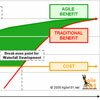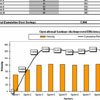Archive for July, 2009

Scrum Meeting Schedule – Two-Week Sprint
So, you’ve heard about Agile and Scrum, your company is sold into the benefits, you’ve had your Scrum Master training, you’re good to go… and now you need to set up all of the meetings! This post will give you a simple overview of the Scrum Meetings and some suggestions for how you might like to schedule/run them.
4 comments | Read more
Scrum Sprint Planning Meetings – Who, What, When, Where, Why
Sprint planning should take place on the first day of the sprint. This session is divided into two parts, the first part is attended by the delivery team and the product manager, whereas the second part is usually only attended by the delivery team.
1 comment | Read more
Self-Funding Projects – A Benefit of Agile Software Development
One of the many benefits of developing software in an iterative way is that you can start realising the benefit of your work before the project is officially ‘finished’.
6 comments | Read more
Value Points – Estimating the relative value of a User Story
Value Points can be used to measure the relative value of stories using a Fibonnaci Sequence. Although not appropriate or particularly necessary in all cases e.g. primarily when you have an omni-present Product Manager, these can be a useful way to prioritise and convey relative importance to a team. This approach becomes increasingly useful as teams scale to cover multiple projects combined with Business As Usual activities.
6 comments | Read more
The Agile Balanced Scorecard – Tracking the Quality of an Agile Software Development Team
Quality is one of the four performance measures that you should consider when building an Agile Balanced Scorecard. The other three are Value, Velocity and Reliability.
1 comment | Read more
The Agile Balanced Scorecard – Tracking the Reliability of an Agile Software Development Team
Reliability is one of the four performance measures that you should consider when building an Agile Balanced Scorecard. The other three are Value, Velocity and Quality.
2 comments | Read more
Agile Balanced Scorecard – Measuring the effectiveness of an Agile Software Development Team
Velocity does by definition assume a degree of quality output by any Agile Software Development Team, by the virtue of the fact that you should only count accepted Story Points towards your velocity.
With that said, there are many other factors that need to be considered when assessing the overall effectiveness of the team.
3 comments | Read more
Using Velocity to measure the Productivity of an Agile Development Team
Although you can not use Velocity to measure the productivity of one team compared to another, you can use velocity to help track the relative productivity of the same team from one sprint to another assuming the value of a point stays the same over time.
1 comment | Read more
Software Estimation – the more precise you are, the less accurate you will be!
We often confuse ‘accurate’ (mean difference) with ‘precise (variance)’. It would be accurate to say that I was less than six foot tall, it would be precise to say that I was…
3 comments | Read more
Calculating the ROI of Implementing Agile Practices – Agile increases output and efficiency
So, it’s no secret that one of the big benefits of ‘going agile’ is the ability/opportunity to track and optimise team performance.
The big question from a programme management and business perspective is:
How do you measure the operational costs/savings associated with improved efficiency or increased disruption within an Agile Software Development team?
3 comments | Read more